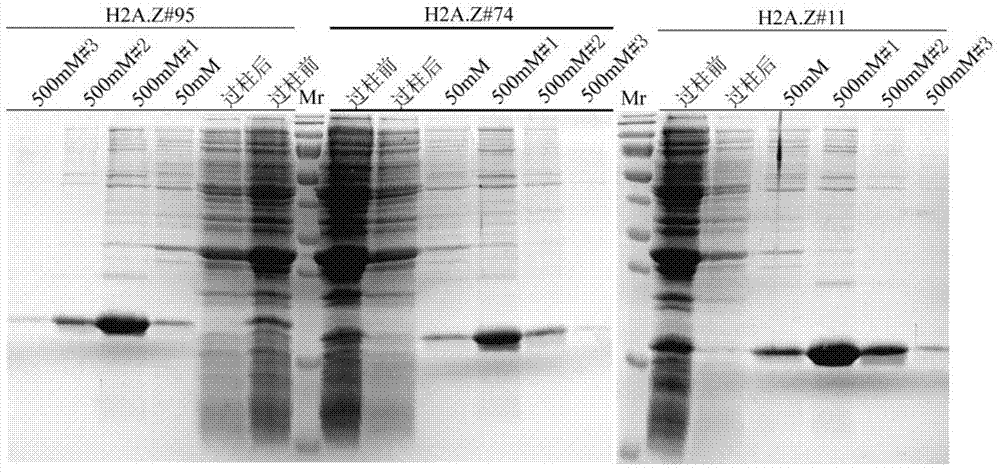Nanometer antibody, encoding sequence and application of H2A.Z variant
A nanobody, sequence technology, applied to the nanobody against H2A.Z variant, its coding sequence and application field, can solve the problem of nanobody lacking light chain and so on
- Summary
- Abstract
- Description
- Claims
- Application Information
AI Technical Summary
Problems solved by technology
Method used
Image
Examples
Embodiment 1
[0029] Construction of nanobody library against histone H2A.Z:
[0030](1) Mix 1 mg H2A.Z with Freund's adjuvant in equal volume, immunize a Xinjiang dromedary, once a week, immunize 7 times in total, and stimulate B cells to express antigen-specific nanobodies; (2) 7 After the first immunization, 100 mL camel peripheral blood lymphocytes were extracted and total RNA was extracted; (3) cDNA was synthesized and VHH was amplified by nested PCR; (4) 20 ug of pMECS vector and 10 ug VHH and ligated the two fragments; (5) Transformed the ligated product into electroporation-competent TG1 cells to construct the H2A.Z nanobody library and measure the library capacity, which was 1.15×10 8 .
Embodiment 2
[0032] H2A.Z nanobody screening process:
[0033] (1) Dissolve in 100 mM NaHCO 3 20 ug H2A.Z in (pH=8.2) was coupled to NUNC plate,
[0034] Place overnight at 4°C; (2) add 100 uL 0.1% casein the next day, block at room temperature for 2 h; (3) add 100 uL phage (5×10 11 tfu immunized camel nanobody phage display gene library) and reacted at room temperature for 1 h; (4) Washed 5 times with 0.05% PBS+Tween-20 to wash off unbound phages; (5) Washed with 100 mM TEA (triethylamine) Dissociate the phage that specifically binds to H2A.Z, infect Escherichia coli TG1 in the logarithmic growth phase, culture at 37 °C for 1 h, produce and purify the phage for the next round of screening, repeat the same screening process for 3-4 rounds, gradually enriched.
Embodiment 3
[0036] Use phage enzyme-linked immunosorbent assay (ELISA) to screen specific single positive clones:
[0037] (1) After 3-4 rounds of screening, select 96 single colonies from the cell culture plate containing phage and inoculate them in a 24-well cell culture plate. After growing to the logarithmic phase, add 1 mM IPTG and culture overnight at 28 °C ; (2) Obtain crude antibody by permeation method, transfer the antibody to an antigen-coated ELISA plate, and place it at room temperature for 1 h; (3) Wash unbound antibody with PBST, add mouse anti-HA tag antibody at room temperature for 1 h; (4) wash off unbound antibodies with PBST, add anti-mouse alkaline phosphatase conjugate, and place at room temperature for 1 h; (5) wash off unbound antibodies with PBST, add chromogenic solution, and use ELISA On the instrument, read the absorbance value at a wavelength of 405 nm; (6) When the OD value of the sample well is more than 2 times greater than the OD value of the control well,...
PUM
 Login to View More
Login to View More Abstract
Description
Claims
Application Information
 Login to View More
Login to View More - R&D
- Intellectual Property
- Life Sciences
- Materials
- Tech Scout
- Unparalleled Data Quality
- Higher Quality Content
- 60% Fewer Hallucinations
Browse by: Latest US Patents, China's latest patents, Technical Efficacy Thesaurus, Application Domain, Technology Topic, Popular Technical Reports.
© 2025 PatSnap. All rights reserved.Legal|Privacy policy|Modern Slavery Act Transparency Statement|Sitemap|About US| Contact US: help@patsnap.com



